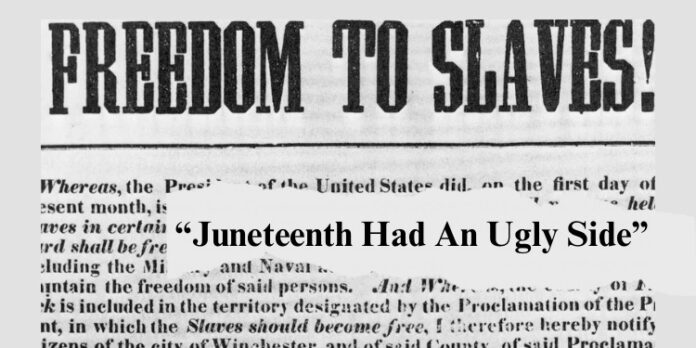Juneteenth Had an Ugly Side
According to James Smallwood (1981), in his book, Time of Hope, Time of Despair, the historical backdrop of slavery, white supremacy, and racial oppression can be unearthed by reviewing the historical events that poisoned the nation for hundreds of years. These racialized historical points include: the Three-Fifths Compromise (1787), the war with Mexico (1836), the U. S .Mexican War (1846), the Compromise of 1850, the Fugitive Slave Act, the publication of Uncle Tom’s Cabin (1852), the rise of the Knights of the Golden Circle (KGC) in the 1850s, the Kansas-Nebraska Act of 1854, the war between Kansas and Missouri (1854-1859), the beating of Senator Charles Sumner by pro-slavery Senator Preston Brooks (1856), the Dred Scott Decision (1857), John Brown’s raid at Harpers Ferry (1859), the election of Abraham Lincoln (1860), vagrancy laws passed by southern states to sabotage the Thirteenth Amendment (Slavery by Another Name), the case of Plessy vs. Ferguson (1896), and the subsequent establishment of Jim Crow law, lynching, the burning alive of Blacks in East Texas, and many other events that kept white supremacy as an accepted norm.
The pathways by which Black people navigated their lives after the Civil War, was dangerous given the opposition to Reconstruction in Texas. According to Smallwood, former slaves welcomed freedom when Juneteenth news came to Texas in the form of a military order delivered to Galveston Island by General Gordon Granger as the beginning of a better life. Though the announcement of freedom was welcomed by Black people, the order carried with it the underlying mandates of white supremacy.
Racists killed many blacks if they were caught celebrating freedom. According to Smallwood, “the Sheriff of DeWitt County shot a black for whistling Yankee Doodle, while in Red River County Anglos murdered blacks for the fun of it.” In Limestone County, a place that is still seething with racism, one racist said he killed all the “Freemen he could catch,” and in 1874 a racist from Goliad County said, “He liked to kill Indians but preferred killing Negroes.” Juneteenth was quite clearly a time of hope and hell. According to Smallwood, in 1869 a black pastor, named George Porter, was murdered by white racists because he was providing advice about their civil rights under federal Reconstruction.
The forced contract labors, that Gordon Granger ordered on June 19, 1865, helped to produce the Homestead Act. This law would allow former slave owners to take control of millions of acres of land as a result of the final passage during Texas Legislature 11th session in 1866. It also created vagrancy laws to convict Blacks of violations to prevent them from filing for the available land. This act gave whites millions of acres of land for free and thus created wealth for whites while keeping blacks without land inheritances. This was the case was a free hand out if you were White. The forty acres and a mule promised to Black folk would be scuttled after the Civil War. This was the method by which many in the White population were given racialized welfare at the expense of Black People, Brown People, Indigenous People, and taken away from some whites who supported Lincoln. According to Keri Leigh Merritt (2016) in an article titled, Land and the roots of African-American poverty, the Homestead Act gave approximately 1.6 million Whites land inheritance while only roughly 5,000 Black folks would benefit. Thus, decades of wealth were passed on to Whites while people of color were robbed. Gordon Granger was also responsible for this hell that is never mentioned.








